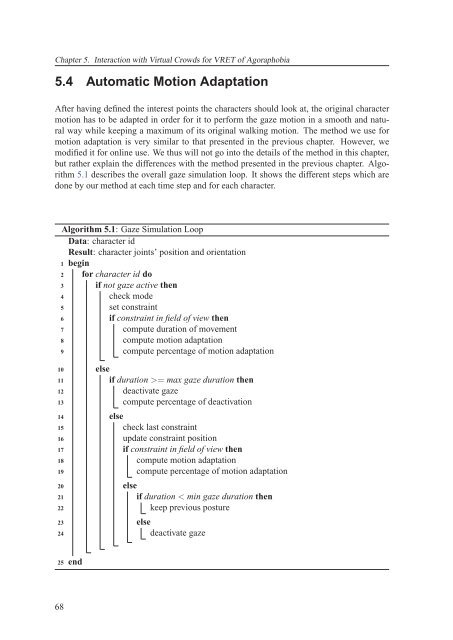Texte intégral / Full text (pdf, 20 MiB) - Infoscience - EPFL
Texte intégral / Full text (pdf, 20 MiB) - Infoscience - EPFL
Texte intégral / Full text (pdf, 20 MiB) - Infoscience - EPFL
You also want an ePaper? Increase the reach of your titles
YUMPU automatically turns print PDFs into web optimized ePapers that Google loves.
Chapter 5. Interaction with Virtual Crowds for VRET of Agoraphobia<br />
5.4 Automatic Motion Adaptation<br />
After having defined the interest points the characters should look at, the original character<br />
motion has to be adapted in order for it to perform the gaze motion in a smooth and natural<br />
way while keeping a maximum of its original walking motion. The method we use for<br />
motion adaptation is very similar to that presented in the previous chapter. However, we<br />
modified it for online use. We thus will not go into the details of the method in this chapter,<br />
but rather explain the differences with the method presented in the previous chapter. Algorithm<br />
5.1 describes the overall gaze simulation loop. It shows the different steps which are<br />
done by our method at each time step and for each character.<br />
Algorithm 5.1: Gaze Simulation Loop<br />
Data: character id<br />
Result: character joints’ position and orientation<br />
1 begin<br />
2 for character id do<br />
3 if not gaze active then<br />
4 check mode<br />
5 set constraint<br />
6 if constraint in field of view then<br />
7<br />
compute duration of movement<br />
8<br />
compute motion adaptation<br />
9<br />
compute percentage of motion adaptation<br />
10<br />
11<br />
12<br />
13<br />
14<br />
15<br />
16<br />
17<br />
18<br />
19<br />
<strong>20</strong><br />
21<br />
22<br />
23<br />
24<br />
25<br />
68<br />
end<br />
else<br />
if duration >= max gaze duration then<br />
deactivate gaze<br />
compute percentage of deactivation<br />
else<br />
check last constraint<br />
update constraint position<br />
if constraint in field of view then<br />
compute motion adaptation<br />
compute percentage of motion adaptation<br />
else<br />
if duration < min gaze duration then<br />
keep previous posture<br />
else<br />
deactivate gaze

















